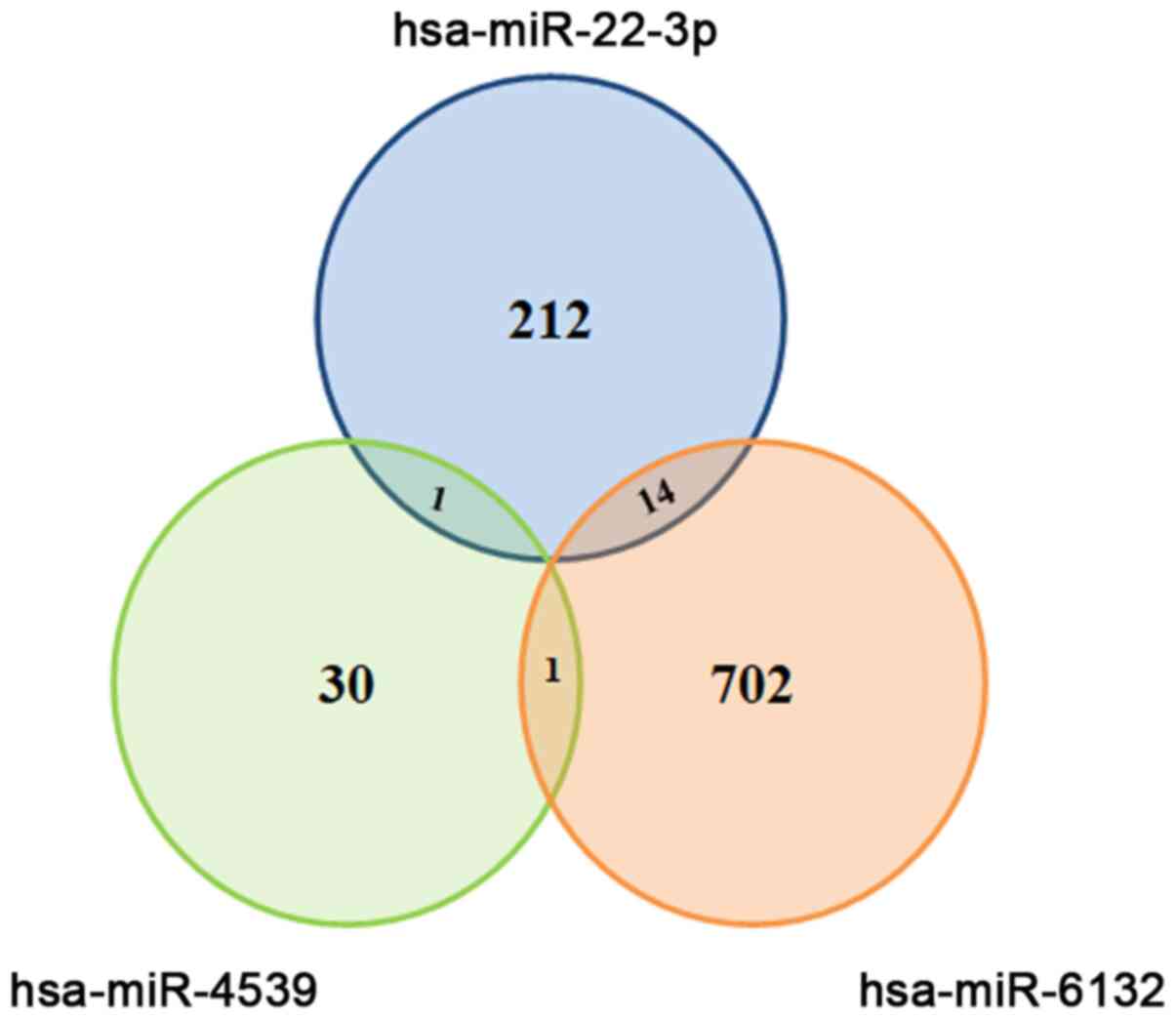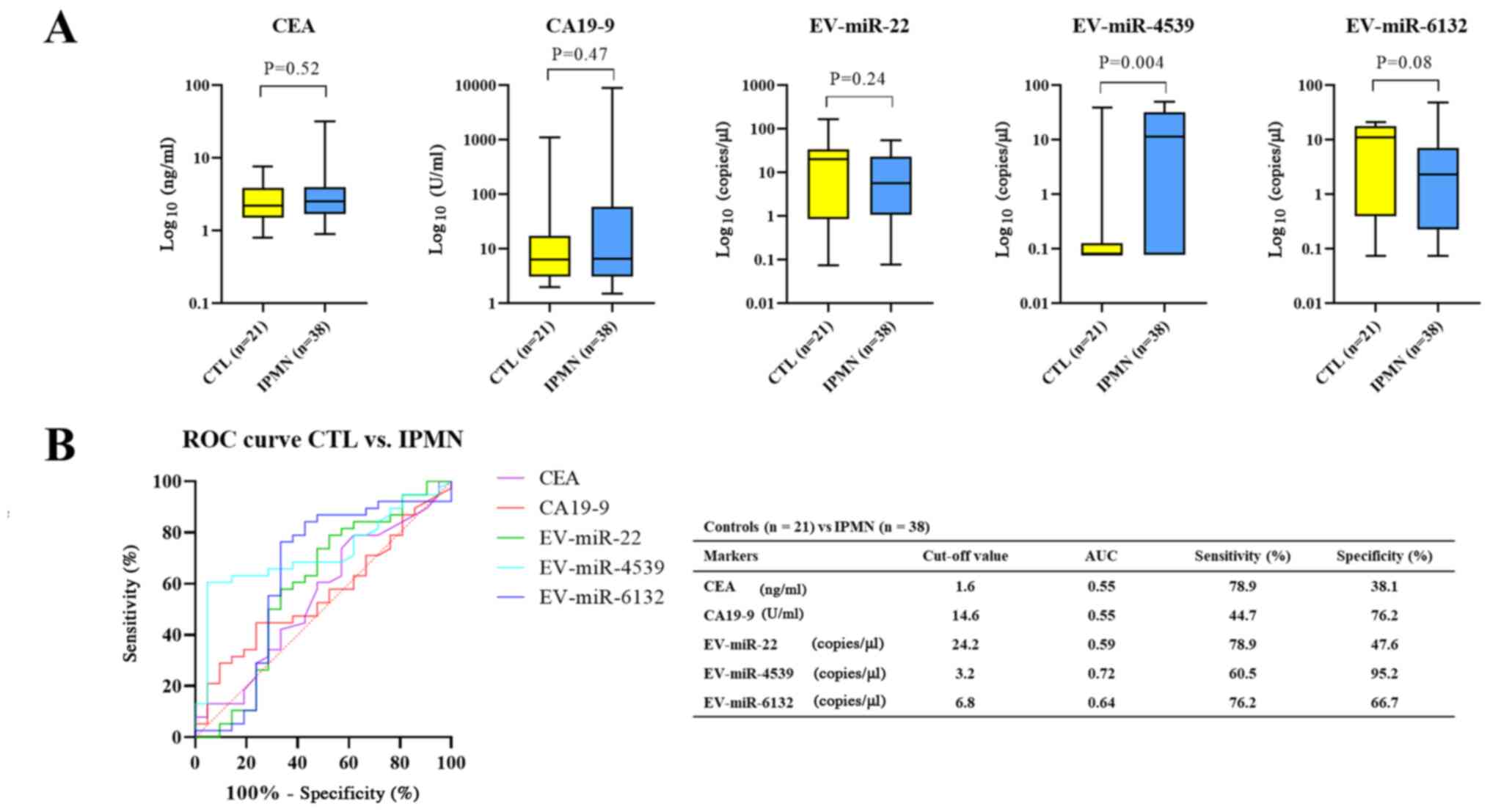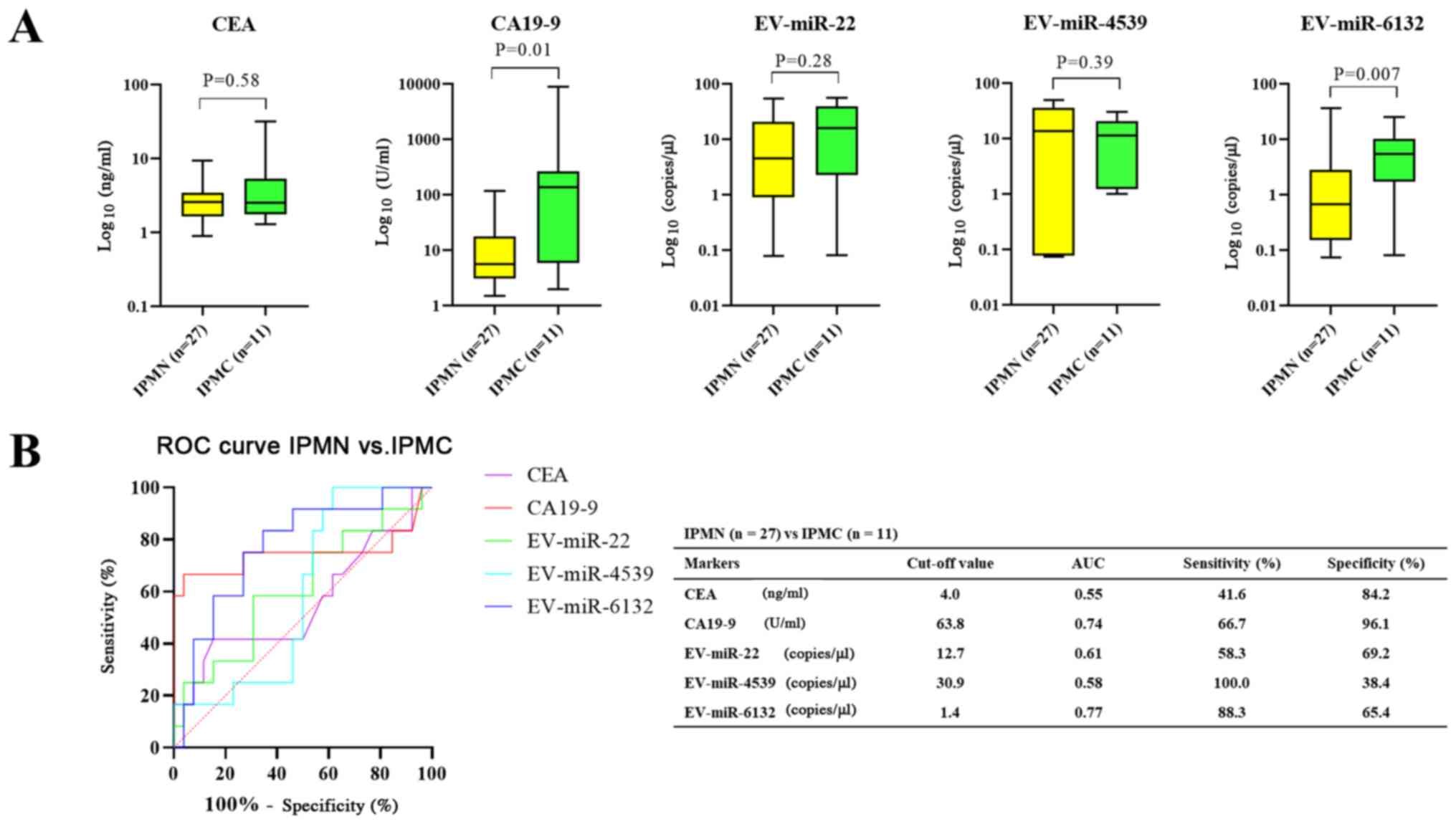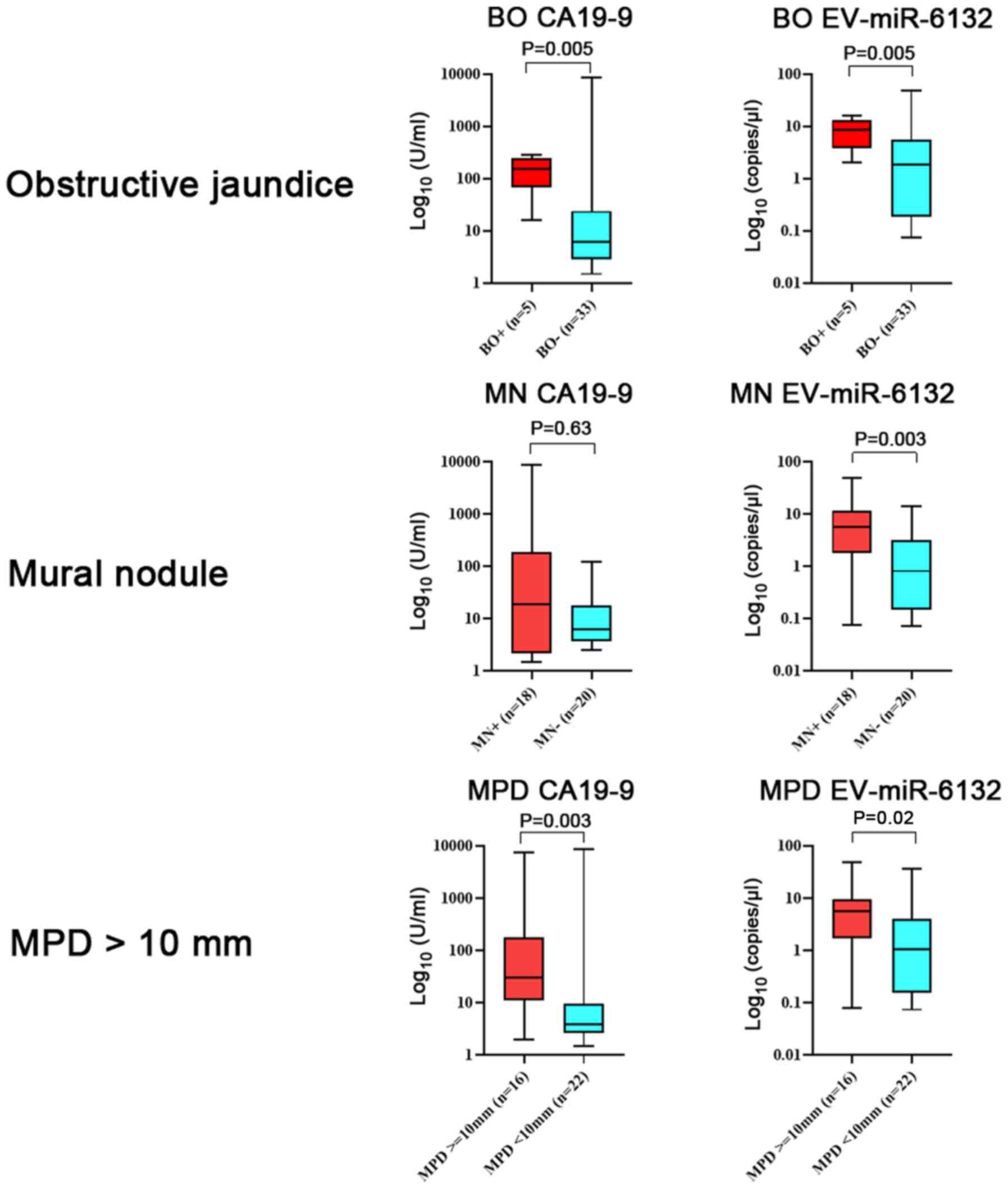|
1
|
Tanaka M, Fernandez-Del Castillo C,
Kamisawa T, Jang JY, Levy P, Ohtsuka T, Salvia R, Shimizu Y, Tada M
and Wolfgang CL: Revisions of international consensus Fukuoka
guidelines for the management of IPMN of the pancreas.
Pancreatology. 17:738–753. 2017. View Article : Google Scholar : PubMed/NCBI
|
|
2
|
Oyama H, Tada M, Takagi K, Tateishi K,
Hamada T, Nakai Y, Hakuta R, Ijichi H, Ishigaki K, Kanai S, et al:
Long-term risk of malignancy in branch-duct intraductal papillary
mucinous neoplasms. Gastroenterology. 158:226–237 e5. 2020.
View Article : Google Scholar : PubMed/NCBI
|
|
3
|
Al-Haddad M, DeWitt J, Sherman S, Schmidt
CM, LeBlanc JK, McHenry L, Coté G, El Chafic AH, Luz L, Stuart JS,
et al: Performance characteristics of molecular (DNA) analysis for
the diagnosis of mucinous pancreatic cysts. Gastrointest Endosc.
79:79–87. 2014. View Article : Google Scholar : PubMed/NCBI
|
|
4
|
Matthaei H, Wylie D, Lloyd MB, Dal Molin
M, Kemppainen J, Mayo SC, Wolfgang CL, Schulick RD, Langfield L,
Andruss BF, et al: mRNA biomarkers in cyst fluid augment the
diagnosis and management of pancreatic cysts. Clin Cancer Res.
18:4713–4724. 2012. View Article : Google Scholar : PubMed/NCBI
|
|
5
|
Takano S, Fukasawa M, Maekawa S, Kadokura
M, Miura M, Shindo H, Takahashi E, Sato T and Enomoto N: Deep
sequencing of cancer-related genes revealed GNAS mutations to be
associated with intraductal papillary mucinous neoplasms and its
main pancreatic duct dilation. PLoS One. 9:e987182014. View Article : Google Scholar : PubMed/NCBI
|
|
6
|
Moris D, Damaskos C, Spartalis E,
Papalampros A, Vernadakis S, Dimitroulis D, Griniatsos J,
Felekouras E and Nikiteas N: Updates and critical evaluation on
novel biomarkers for the malignant progression of intraductal
papillary mucinous neoplasms of the pancreas. Anticancer Res.
37:2185–2194. 2017. View Article : Google Scholar : PubMed/NCBI
|
|
7
|
Tanaka M, Heckler M, Liu B, Heger U,
Hackert T and Michalski CW: Cytologic analysis of pancreatic juice
increases specificity of detection of malignant IPMN-A systematic
review. Clin Gastroenterol Hepatol. 17:2199–2211 e21. 2019.
View Article : Google Scholar : PubMed/NCBI
|
|
8
|
Reddy KB: MicroRNA (miRNA) in cancer.
Cancer Cell Int. 15:382015. View Article : Google Scholar : PubMed/NCBI
|
|
9
|
Peng Y and Croce CM: The role of microRNAs
in human cancer. Signal Transduct Target Ther. 1:150042016.
View Article : Google Scholar : PubMed/NCBI
|
|
10
|
Jansson MD and Lund AH: MicroRNA and
cancer. Mol Oncol. 6:590–610. 2012. View Article : Google Scholar : PubMed/NCBI
|
|
11
|
Hayes J, Peruzzi PP and Lawler S:
MicroRNAs in cancer: Biomarkers, functions and therapy. Trends Mol
Med. 20:460–469. 2014. View Article : Google Scholar : PubMed/NCBI
|
|
12
|
de Miguel Perez D, Rodriguez Martinez A,
Ortigosa Palomo A, Delgado Ureña M, Garcia Puche JL, Robles Remacho
A, Exposito Hernandez J, Lorente Acosta JA, Ortega Sánchez FG and
Serrano MJ: Extracellular vesicle-miRNAs as liquid biopsy
biomarkers for disease identification and prognosis in metastatic
colorectal cancer patients. Sci Rep. 10:39742020. View Article : Google Scholar : PubMed/NCBI
|
|
13
|
Conte D, Verri C, Borzi C, Suatoni P,
Pastorino U, Sozzi G and Fortunato O: Novel method to detect
microRNAs using chip-based QuantStudio 3D digital PCR. BMC
Genomics. 16:8492015. View Article : Google Scholar : PubMed/NCBI
|
|
14
|
Suzuki R, Asama H, Waragai Y, Takagi T,
Hikichi T, Sugimoto M, Konno N, Watanabe K, Nakamura J, Kikuchi H,
et al: Fibrosis-related miRNAs as serum biomarkers for pancreatic
ductal adenocarcinoma. Oncotarget. 9:4451–4460. 2017. View Article : Google Scholar : PubMed/NCBI
|
|
15
|
Vlachos IS, Zagganas K, Paraskevopoulou
MD, Georgakilas G, Karagkouni D, Vergoulis T, Dalamagas T and
Hatzigeorgiou AG: DIANA-miRPath v3.0: Deciphering microRNA function
with experimental support. Nucleic Acids Res. 43((W1)): W460–W466.
2015. View Article : Google Scholar : PubMed/NCBI
|
|
16
|
House MG, Guo M, Iacobuzio-Donahue C and
Herman JG: Molecular progression of promoter methylation in
intraductal papillary mucinous neoplasms (IPMN) of the pancreas.
Carcinogenesis. 24:193–198. 2003. View Article : Google Scholar : PubMed/NCBI
|
|
17
|
Huang da W, Sherman BT, Zheng X, Yang J,
Imamichi T, Stephens R and Lempicki RA: Extracting biological
meaning from large gene lists with DAVID. Curr Protoc
Bioinformatics Chapter. 13:Unit 13 11. 2009.doi:
10.1002/0471250953.bi1311s27.
|
|
18
|
Huang da W, Sherman BT and Lempicki RA:
Bioinformatics enrichment tools: Paths toward the comprehensive
functional analysis of large gene lists. Nucleic Acids Res.
37:1–13. 2009. View Article : Google Scholar : PubMed/NCBI
|
|
19
|
Habbe N, Koorstra JB, Mendell JT,
Offerhaus GJ, Ryu JK, Feldmann G, Mullendore ME, Goggins MG, Hong
SM and Maitra A: MicroRNA miR-155 is a biomarker of early
pancreatic neoplasia. Cancer Biol Ther. 8:340–346. 2009. View Article : Google Scholar : PubMed/NCBI
|
|
20
|
Goto T, Fujiya M, Konishi H, Sasajima J,
Fujibayashi S, Hayashi A, Utsumi T, Sato H, Iwama T, Ijiri M, et
al: An elevated expression of serum exosomal microRNA-191, −21,
−451a of pancreatic neoplasm is considered to be efficient
diagnostic marker. BMC Cancer. 18:1162018. View Article : Google Scholar : PubMed/NCBI
|
|
21
|
Pasqualini L, Bu H, Puhr M, Narisu N,
Rainer J, Schlick B, Schäfer G, Angelova M, Trajanoski Z, Börno ST,
et al: mR-22 and miR-29a are members of the androgen receptor
cistrome modulating LAMC1 and Mcl-1 in prostate cancer. Mol
Endocrinol. 29:1037–1054. 2015. View Article : Google Scholar : PubMed/NCBI
|
|
22
|
Wang G, Shen N, Cheng L, Lin J and Li K:
Downregulation of miR-22 acts as an unfavorable prognostic
biomarker in osteosarcoma. Tumour Biol. 36:7891–7895. 2015.
View Article : Google Scholar : PubMed/NCBI
|
|
23
|
Bersani F, Lingua MF, Morena D, Foglizzo
V, Miretti S, Lanzetti L, Carrà G, Morotti A, Ala U, Provero P, et
al: Deep sequencing reveals a novel miR-Regulatory network with
therapeutic potential in rhabdomyosarcoma. Cancer Res.
76:6095–6106. 2016. View Article : Google Scholar : PubMed/NCBI
|
|
24
|
Koufaris C, Valbuena GN, Pomyen Y,
Tredwell GD, Nevedomskaya E, Lau CH, Yang T, Benito A, Ellis JK and
Keun HC: Systematic integration of molecular profiles identifies
miR-22 as a regulator of lipid and folate metabolism in breast
cancer cells. Oncogene. 35:2766–2776. 2016. View Article : Google Scholar : PubMed/NCBI
|
|
25
|
Jafarzadeh-Samani Z, Sohrabi S,
Shirmohammadi K, Effatpanah H, Yadegarazari R and Saidijam M:
Evaluation of miR-22 and miR-20a as diagnostic biomarkers for
gastric cancer. Chin Clin Oncol. 6:162017. View Article : Google Scholar : PubMed/NCBI
|
|
26
|
Fu Q, Liu CJ, Zhang X, Zhai ZS, Wang YZ,
Hu MX, Xu XL, Zhang HW and Qin T: Glucocorticoid receptor regulates
expression of microRNA-22 and downstream signaling pathway in
apoptosis of pancreatic acinar cells. World J Gastroenterol.
24:5120–5130. 2018. View Article : Google Scholar : PubMed/NCBI
|
|
27
|
Sui J, Liu Q, Zhang H and Kong Y: Deep
integrative analysis of microRNA-mRNA regulatory networks for
biomarker and target discovery in chondrosarcoma. J Cell Biochem.
120:9631–9638. 2019. View Article : Google Scholar : PubMed/NCBI
|
|
28
|
Wang D, Guo C, Kong T, Mi G, Li J and Sun
Y: Serum miR-22 may be a biomarker for papillary thyroid cancer.
Oncol Lett. 17:3355–3361. 2019.PubMed/NCBI
|
|
29
|
Pellatt DF, Stevens JR, Wolff RK, Mullany
LE, Herrick JS, Samowitz W and Slattery ML: Expression profiles of
miRNA subsets distinguish human colorectal carcinoma and normal
colonic mucosa. Clin Transl Gastroenterol. 7:e1522016. View Article : Google Scholar : PubMed/NCBI
|
|
30
|
Medarova Z, Pantazopoulos P and Yoo B:
Screening of potential miRNA therapeutics for the prevention of
multi-drug resistance in cancer cells. Sci Rep. 10:19702020.
View Article : Google Scholar : PubMed/NCBI
|
|
31
|
Garaude J, Kent A, van Rooijen N and
Blander JM: Simultaneous targeting of toll- and nod-like receptors
induces effective tumor-specific immune responses. Sci Transl Med.
4:120ra1162012. View Article : Google Scholar
|


















